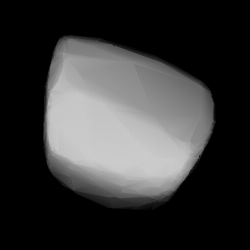 3D model based on lightcurve data | |
| Discovery | |
|---|---|
| Discovered by | N. R. Pogson |
| Discovery date | 6 February 1885 |
| Designations | |
| (245) Vera | |
| Pronunciation | /ˈvɪərə/ |
| A885 CA, 1919 HB | |
| Main belt | |
| Orbital characteristics[1] | |
| Epoch 31 July 2016 (JD 2457600.5) | |
| Uncertainty parameter 0 | |
| Observation arc | 131.06 yr (47,869 d) |
| Aphelion | 3.70600 AU (554.410 Gm) |
| Perihelion | 2.50409 AU (374.607 Gm) |
| 3.10504 AU (464.507 Gm) | |
| Eccentricity | 0.19354 |
| 5.47 yr (1,998.5 d) | |
Average orbital speed | 16.93 km/s |
| 120.926° | |
| 0° 10m 48.493s / day | |
| Inclination | 5.15859° |
| 61.2968° | |
| 329.674° | |
| Physical characteristics | |
| Dimensions | 79.50±3.2 km |
| 14.38 h (0.599 d) | |
| 0.2082±0.018 | |
| Temperature | unknown |
| S[2] | |
| 7.82 | |
245 Vera is a large Main belt asteroid. It was discovered by N. R. Pogson on February 6, 1885, in Madras,[3] and was named at the suggestion of his wife.[4] The asteroid is orbiting the Sun at a distance of 3.11 AU with a period of 5.47 years and an eccentricity (ovalness) of 0.19. The orbital plane is tilted at an angle of 5.16° to the plane of the ecliptic.[1] In 1890, Daniel Kirkwood noted that this asteroid shares similar orbital elements with 86 Semele and 106 Dione.[5]
Photometric measurements of this asteroid made during 1980–1981 were used to produce a light curve that demonstrated a rotation period of 14.38±0.03 h with a brightness variation of 0.26±0.01 in magnitude.[6] It is classified as a stony S-type asteroid in the Tholen system.[2] The asteroid has an estimated diameter of 75.95±2.63 km based on near infrared observations.[7]
- ^ a b Cite error: The named reference
jpldatawas invoked but never defined (see the help page). - ^ a b Cite error: The named reference
Xu_et_al_1995was invoked but never defined (see the help page). - ^ Cite error: The named reference
IAUwas invoked but never defined (see the help page). - ^ Cite error: The named reference
Schmadel2013was invoked but never defined (see the help page). - ^ Cite error: The named reference
Kirkwood1890was invoked but never defined (see the help page). - ^ Cite error: The named reference
Debehogne_et_al_1982was invoked but never defined (see the help page). - ^ Cite error: The named reference
Masiero_et_al_2014was invoked but never defined (see the help page).